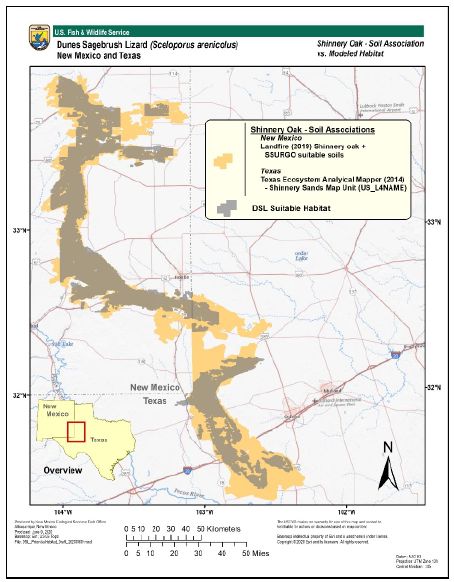On July 3, 2023, the U.S. Fish and Wildlife Service (FWS) proposed to list the dunes sagebrush lizard as endangered. The dunes sagebrush lizard exists solely in shinnery oak duneland complexes in the Permian Basin, both in Texas and New Mexico.

FWS has considered dunes sagebrush lizard to be a species of concern for decades. FWS first identified the dunes sagebrush lizard, then known as the "sand dune lizard," as a candidate for listing in 1982. The species remained a candidate species when FWS proposed to list it in 2010. In 2012, however, FWS withdrew its proposed listing rule after concluding that conservation efforts addressed and alleviated threats to the species adequately for it to continue to be viable into the future.
FWS based its new proposal to list the dunes sagebrush lizard as endangered principally on past and projected future impacts to the species from oil and gas development and frac sands mining. Specifically, FWS based its listing proposal on several determinations, including that: 1) nearly half of shinnery oak duneland habitat has been degraded so that it is no longer capable of supporting populations of the species; 2) habitat fragmentation caused by oil and natural gas development and frac sands mining is likely to continue to occur in the future; and 3) even if no new development occurs in the species' habitat, existing oil and gas development will continue to negatively impact the species and make it vulnerable to other threats. FWS's proposed listing rule relied on a species status assessment it recently finalized.
Notably, FWS has not proposed to designate critical habitat with the proposed listing rule.
The Effect of Listing on Land Users – Incidental Take Prohibition & Section 7 Consultation
Listing wildlife as endangered has two effects on land users. First, the ESA prohibits take of endangered wildlife. Second, a federal agency must consult with FWS before issuing a permit or land use authorization that may affect an endangered species.
The ESA prohibits take of endangered wildlife, which is defined to include harming, harassing, and killing endangered wildlife, among other actions. The ESA's prohibition on take includes both intentional take and take that occurs unintentionally as the result of otherwise lawful activities, such as energy development ("incidental take").
The proposed rule identifies the following actions as potentially resulting in prohibited take of dunes sagebrush lizard:
- Destruction, alteration, or removal of shinnery oak duneland and shrubland vegetation;
- Degradation, removal, or fragmentation of shinnery oak duneland and shrubland formations and ecosystems;
- Disruption of water tables in dunes sagebrush lizard habitat;
- Introduction of nonnative species that compete with or prey upon the dunes sagebrush lizard;
- Unauthorized release of biological control agents that attack any life stage of the dunes sagebrush lizard or that degrade or alter its habitat; and
- Herbicide or pesticide applications in shinnery oak duneland and shrubland vegetation and ecosystems.
To engage in land use activities that will result in incidental take of endangered wildlife on private lands, land users must obtain a permit from FWS. To obtain a permit, the land user must have entered into a candidate conservation with assurances (CCAA) with FWS prior to listing or must develop an approved habitat conservation plan.
In New Mexico, the Center for Excellence ("CEHMM") administers a CCAA for oil and gas operators on private lands. Prior to the effective date of any listing decision, an operator may execute a written agreement with CEHMM committing to adhere to certain conservation measures to protect the dunes sagebrush lizard. If and when the dunes sagebrush lizard is listed, an enhancement of survival permit accompanying the CCAA will authorize any incidental take that occurs as the result of activities conducted in accordance with the agreement.
In Texas, two conservation plans have been developed. One conservation plan is a CCAA that covers oil and gas activities, agriculture, and ranching activities. The other conservation plan is a CCAA that covers oil and gas activities, sand mining, linear infrastructure, wind, solar, local governments, agriculture, and ranching. As the preamble to the proposed rule details, however, few land users are participating in these conservation plans.
In addition to prohibiting take of endangered species, the ESA requires federal agencies to consult with FWS to ensure their actions do not jeopardize the continued existence of endangered species, in a process known as "section 7 consultation." Section 7 consultation can lead to delay and additional conservation measures. With respect to the dunes sagebrush lizard, the Bureau of Land Management (BLM) must consult with FWS before issuing leases, permits, and rights-of-way for energy and other land uses in southeast New Mexico. In New Mexico, CEHMM administers a Candidate Conservation Agreement on federal lands. Prior to the effective of a listing, an operator may execute a written agreement committing to adhere to certain conservation measures to protect the dunes sagebrush lizard; in exchange, the operator will enjoy a streamlined process for section 7 consultation and a high degree of certainty that FWS will not require additional conservation measures.
Public Participation & Next Steps
FWS is accepting public comment on the proposed listing rule until September 1, 2023. On July 31, 2023, FWS will hold a public informational session from 5 to 6 p.m. and a public hearing from 6 to 8 p.m., mountain standard time.
The ESA directs that FWS must issue a final listing rule or to withdraw the proposed rule within one year of publication of the proposed rule (i.e., by July 3, 2024). The ESA allows FWS to extend this deadline by six months if there is substantial disagreement regarding the sufficiency or accuracy of available data relevant to the proposed listing rule.
The content of this article is intended to provide a general guide to the subject matter. Specialist advice should be sought about your specific circumstances.

